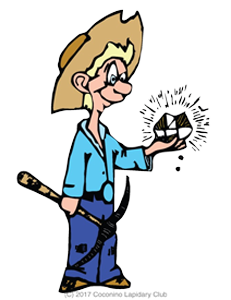The atoms within the crystal of a mineral are arranged in a regular fashion to form a lattice, and the crystal exhibits a shape with surface regularity which reflects its internal symmetry[Ref1]. The shape of a crystal is often typical of a mineral. and often typical the location where found; thus, crystal shape comprised of crystallographic forms modulated by crystal habit can be a useful tool in mineral identification.
The crystals of all minerals fall into seven families defined by their required symmetries as given in the table in Figure 1[Ref2]. The hexagonal family comprises two crystal systems as seen in Figure 1. Planes and shapes which enclose space as shown in Reference 3 are the crystallographic forms which comprise the shapes of crystals exhibited by minerals. The basic forms exhibited by the seven crystal systems are shown in Figure 2. Environmental conditions during deposition can influence the both the forms present on the crystal and the habit of a crystal in influencing its shape [Ref5].


Gallery of Crystal Systems, Forms, and Habits
In order to introduce some of the forms and habits of crystals I’ll use examples of minerals we often have enjoyed seeing in the literature and at lapidary and mineral shows as shown in Figures 3-9.
CUBIC CRYSTAL SYSTEM

TETRAGONAL CRYSTAL SYSTEM

ORTHORHOMBIC CRYSTAL SYSTEM

Pashan Pune District, Maharashtra State, India[Ref5,10].
HEXAGONAL CRYSTAL SYSTEM


TRIGONAL CRYSTAL SYSTEM


MONOCLINIC CRYSTAL SYSTEM

TRICLINIC CRYSTAL SYSTEM

REFERENCES
Ref 1. https://www3.nd.edu/~amoukasi/CBE30361/Lecture__crystallography_A.pdf
Ref 2. https://en.wikipedia.org/wiki/Crystal_system
Ref 3. https://www.tulane.edu/~sanelson/eens211/forms_zones_habit.htm
Ref 4. http://www.geologyin.com/2014/11/crystal-structure-and-crystal-system.html
Ref 5. https://en.wikipedia.org/wiki/Crystal_habit
Ref 6. http://www.galleries.com/minerals/property/habits.htm
Ref 7. http://www.minsocam.org/msa/collectors_corner/id/mineral_id_keyi8.htm
Ref 8. https://www.youtube.com/watch?v=f_g3r79mG9s
Ref 9. https://www.pinterest.com/pin/369506344411688204/
Ref 10. https://www.mindat.org/photo-303305.html
Ref 11. https://www.irocks.com/minerals/specimen/42517
Ref 12. https://www.rockngem.com/uncommon-emerald-exhibit-opening-sept-26/
Ref 13. https://www.spiritrockshop.com/Calcite_Mariposa.html
Ref 14. https://www.fabreminerals.com/LargePhoto.php?FILE=Calcite-SH47AB1f.jpg&LANG=EN
